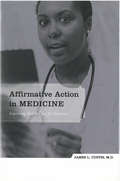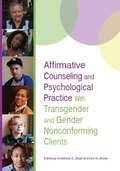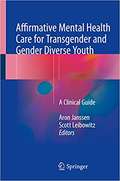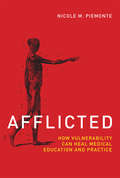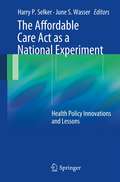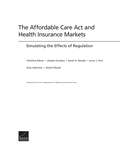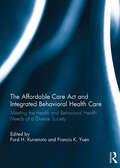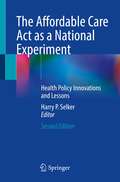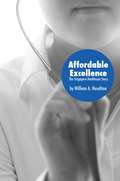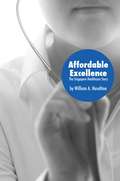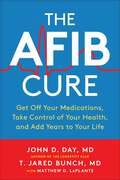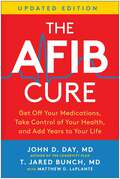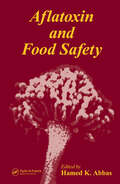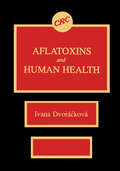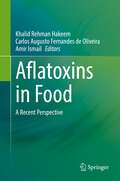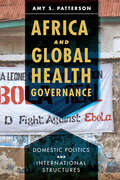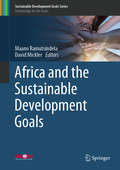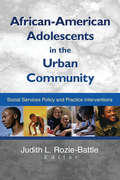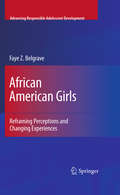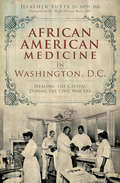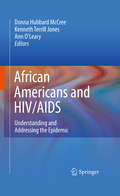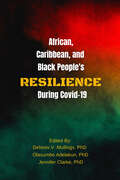- Table View
- List View
Affirmative Action in Medicine: Improving Health Care for Everyone
by James L. CurtisAffirmative action programs have significantly changed American medicine for the better, not only in medical school admissions and access to postgraduate training but also in bringing a higher quality of health care to all people. James L. Curtis approaches this important transition from historical, statistical, and personal perspectives. He tells how over the course of his medical education and career as a psychiatrist and professor--often as the first or only African American in his cohort--the status of minorities in the medical professions grew from a tiny percentage to a far more equitable representation of the American population. Advancing arguments from his earlier book, Blacks, Medical Schools, and Society, Curtis evaluates the outcomes of affirmative action efforts over the past thirty years. He describes formidable barriers to minority access to medical-education opportunities and the resulting problems faced by minority patients in receiving medical treatment. His progress report includes a review of two thousand minority students admitted to U. S. medical schools in 1969, following them through graduation and their careers, comparing them with the careers of two thousand of their nonminority peers. These samples provide an important look at medical schools that, while heralding dramatic progress in physician education and training opportunity, indicates much room for further improvement. A basic hurdle continues to face African Americans and other minorities who are still confined to segregated neighborhoods and inferior school systems that stifle full scholastic development. Curtis urges us as a nation to develop all our human resources through an expansion of affirmative action programs, thus improving health care for everyone. James L. Curtis is Clinical Professor Emeritus of Psychiatry, Columbia University College of Physicians and Surgeons.
Affirmative Counseling and Psychological Practice with Transgender and Gender Nonconforming Clients
by Anneliese A. Singh Lore M. DickeyFewer than 30% of psychologists report familiarity with transgender and gender nonconforming (TGNC) clients' needs, which indicates a large gap in knowledge, skill, and competence in this area of practice. This volume provides mental health practitioners with theory-driven strategies for affirmative practice with TGNC clients of different ages, ethnicities, sexual orientations, and religious backgrounds.
Affirmative Mental Health Care for Transgender and Gender Diverse Youth: A Clinical Guide
by Aron Janssen Scott LeibowitzSimulates a range of complexity in the clinical cases to mirror real life examples.<P><P> Discusses the potential associations between gender identity and gender expression and co-occurring psychiatric conditions and how to tease them apart.<P> Written by experts in the field.<P>This unique resource offers an in-depth, comprehensive look at different types of mental health needs of transgender and gender diverse youth, how these intersect with gender identity, gender expression, and sexual orientation, and provides practical information on how to ethically, responsibly, and sensitively care for these patients.<P> Affirmative Mental Health Care for Transgender and Gender Diverse Youth: A Clinical Guide begins with three introductory chapters which contain practical information regarding assessment, psychological interventions, and the potential medical and surgical interventions that are indicated for youth with gender identity concerns. The remaining chapters are illustrated by multiple cases build around overarching chapter themes. Each case chapter opens with broad questions applicable to clinical practices, while the cases themselves focus on a particular co-occuring mental health condition. The case chapters are structured with intersectionality in mind, including elements of ethnic, racial, and cultural diversity, and the patients range over the full developmental spectrum, from pre-pubertal children to older adolescents. Chapter cases range in complexity as well, to provide readers with the tools they need to evaluate patients, and to assist in the decision of which presenting factors to prioritize in treatment at which time. Ending each chapter are clinical take-home messages, closing with additional practical knowledge that can be applied to other cases providers may see in their own practices.<P> Written by expert clinicians in the field, Affirmative Mental Health Care for Transgender and Gender Diverse Youth: A Clinical Guide is an ideal resource not only for child and adolescent psychiatrists, but for clinicians across all mental health disciplines working with gender non-conforming youth, and who are interested in providing informed, affirmative, and intersectional care.
Afflicted: How Vulnerability Can Heal Medical Education and Practice (Basic Bioethics)
by Nicole M. PiemonteHow medical education and practice can move beyond a narrow focus on biological intervention to recognize the lived experiences of illness, suffering, and death.In Afflicted, Nicole Piemonte examines the preoccupation in medicine with cure over care, arguing that the traditional focus on biological intervention keeps medicine from addressing the complex realities of patient suffering. Although many have pointed to the lack of compassion and empathy in medical practice, few have considered the deeper philosophical, psychological, and ontological reasons for it. Piemonte fills that gap, examining why it is that clinicians and medical trainees largely evade issues of vulnerability and mortality and, doing so, offer patients compromised care. She argues that contemporary medical pedagogy and epistemology are not only shaped by the human tendency to flee from the reality of death and suffering but also perpetuate it. The root of the problem, she writes, is the educational and institutional culture that promotes reductionist understandings of care, illness, and suffering but avoids any authentic confrontation with human suffering and the fear and self-doubt that can come with that confrontation. Through a philosophical analysis of the patient-practitioner encounter, Piemonte argues that the doctor, in escaping from authentic engagement with a patient who is suffering, in fact “escapes from herself.”Piemonte explores the epistemology and pedagogy of medicine, examines its focus on calculative or technical thinking, and considers how “clinical detachment” diminishes physicians. She suggests ways that educators might cultivate the capacity for authentic patient care and proposes specific curricular changes to help students expand their moral imaginations.
Affliction: Health, Disease, Poverty (Forms of Living)
by Veena DasAffliction inaugurates a novel way of understanding the trajectories of health and disease in the context of poverty. Focusing on low-income neighborhoods in Delhi, it stitches together three different sets of issues.First, it examines the different trajectories of illness: What are the circumstances under which illness is absorbed within the normal and when does it exceed the normal—putting resources, relationships, and even one’s world into jeopardy?A second set of issues involves how different healers understand their own practices. The astonishing range of practitioners found in the local markets in the poor neighborhoods of Delhi shows how the magical and the technical are knotted together in the therapeutic experience of healers and patients. The book asks: What is expert knowledge? What is it that the practitioner knows and what does the patient know? How are these different forms of knowledge brought together in the clinical encounter, broadly defined? How does this event of everyday life bear the traces of larger policies at the national and global levels?Finally, the book interrogates the models of disease prevalence and global programming that emphasize surveillance over care and deflect attention away from the specificities of local worlds. Yet the analysis offered retains an openness to different ways of conceptualizing “what is happening” and stimulates a conversation between different disciplinary orientations to health, disease, and poverty.Most studies of health and disease focus on the encounter between patient and practitioner within the space of the clinic. This book instead privileges the networks of relations, institutions, and knowledge over which the experience of illness is dispersed. Instead of thinking of illness as an event set apart from everyday life, it shows the texture of everyday life, the political economy of neighborhoods, as well as the dark side of care. It helps us see how illness is bound by the contexts in which it occurs, while also showing how illness transcends these contexts to say something about the nature of everyday life and the making of subjects.
The Affordable Care Act: A National Experiment
by June Wasser Harry SelkerThis book examines the landmark 2010 Patient Protection and Affordable Care Act (ACA) from the perspective of health policy research as translational science. It delineates a new perspective about the creation and potential impact of the ACA and guides the development of health policy that is supported by best evidence that, in turn, transforms into practice, policy, and public benefit. Told by those involved in the creation and implementation of the ACA, the book reviews the history and impact of this ground-breaking legislation and recommends priorities, objectives, and next steps for translational research as the ACA is implemented. The book includes coverage of these topics: · Objectives of the ACA · Analysis of data collected from healthcare reform programs in Vermont and Massachusetts to inform national implementation of the ACA · Engaging the public in, and building support for, ACA implementation · Interplay of federal, state, and local healthcare policy decisions arising from the enforcement of the ACA Featuring contributions from nationally renowned leaders in healthcare policy, this book adds to the public conversation about the ACA and its role in shaping health policy and contributes to a more realistic, nuanced, and productive understanding of this landmark legislation by physicians, policy makers, and the public. It also provides a framework for next steps in continuing to improve U.S. health policy.
The Affordable Care Act and Health Insurance Markets: Simulating the Effects of Regulation
by Christine Eibner Amado Cordova Sarah A. Nowak Carter C. Price Evan Saltzman Dulani WoodsIn this report, the authors estimate the effects of the Affordable Care Act on health insurance enrollment and premiums for ten states (Florida, Kansas, Louisiana, Minnesota, New Mexico, North Dakota, Ohio, Pennsylvania, South Carolina, and Texas) and for the nation overall, with a focus on outcomes in the nongroup and small group markets.
The Affordable Care Act and Integrated Behavioural Health Care: Meeting the Health and Behavioral Health Needs of a Diverse Society
by Ford H. Kuramoto and Francis K. YuenThis book provides a scholarly discussion of arguably the most important advance in U.S. public health services since Medicare 50 years ago - how the Federal program known as the Patient Care and Affordable Care Act of 2010 (ACA) or "Obamacare" became law. It addresses ACA in terms of its impact on improving health and behavioural health services for key diverse populations in America, including people with disabilities, consumers, women, racial and ethnic minorities, and veterans and their families.From the very beginning, ACA was controversial and the topic of heated political debate at both state and national levels. This book examines more closely how the legislation was developed, including the political history of the act; the many advocacy efforts at the national level and the community-based action strategies at the grassroots level; how ACA will affect a broad cross-section of America; the integration of health and behavioural health services as a key component of ACA; the financing of ACA and parity for behavioural health services.This book was originally published as a special issue of the Journal of Social Work in Disability & Rehabilitation.
The Affordable Care Act as a National Experiment: Health Policy Innovations and Lessons
by Harry P. SelkerThe landmark 2010 Patient Protection and Affordable Care Act (ACA), or “Obamacare,” is a topic of great debate in mainstream, academic, and scientific media that generated strong opinions across the political spectrum and our nation. Soon after the enactment of the ACA and the fierce debate that ensued, The Affordable Care Act as a National Experiment was published by Springer in 2014. Now five years later, just finishing an election year in which the ACA was a hotly debated issue, the second edition of this title examines the history, lessons, and impact of this ground-breaking legislation. Now a decade since implementation nationally, the ACA is the largest healthcare policy innovation in the United States in at least 50 years and one of our nation’s largest healthcare experiments ever. The history of public health and medicine shows us that to develop better solutions for important health problems, we must innovate. And when we try a new strategy, we are reminded that to innovate is to experiment. This is the basis of all medical research, public health interventions, and health policy innovations. Moreover, in recent years, there is an increasing emphasis on “translational science,” research that always has an ultimate focus on having real impact on medical care and the public’s health – whether in translating from bench research to the bedside, or from limited clinical use into widespread practice, public health interventions or policy.As with the previous edition, the book opens with a chapter that gives a basic overview of The Affordable Care Act. The second chapter, which previously discussed the objectives of the ACA, now takes a look at the successes, unfinished work and impact of the ACA in the past ten years. The third chapter now ponders the question of whether the ACA has protected patients since its implementation while its previous counterpart gave predictions for the future. The chapters that follow highlight things such as Medicaid expansion and insurance reform under the ACA, the Supreme Court Review of the ACA, social determinants of health, stories of the uninsured and stabilization of the ACA, among others. The book rounds out with a summary of what’s next and the push for universal healthcare followed by an epilogue. Due to the timely nature of the subject matter, some chapters from the previous edition have been dropped and seven new chapters have been added in their place. The remaining seven chapters from the previous edition have also been fully revised and updated. Written by nationally known healthcare policy leaders who were involved directly in the creation and implementation of the ACA, the second edition of The Affordable Care Act as a National Experiment again will examine the history and impact of this ground-breaking legislation as well as recommend priorities, objectives, and next steps for translational research. It is an essential resource for all healthcare providers as well as policy makers and academics.
Affordable Excellence: The Singapore Healthcare Story - How to Create and Manage Sustainable Healthcare Systems
by William A. HaseltineThe United States has been struggling with its health care system for decades. Costs continue to spiral upward, while coverage of the population has decreased because of job losses and the resultant loss of health benefits, due to the Great Recession and the subsequent slow economic recovery. President Clintons attempt to enact a national health care plan failed, and the fate of President Obamas health care plan, under attack since its inception, is uncertain. Since achieving independence, Singapore undertook the monumental task of transforming itself to a modern, prosperous, secure city-state. Many institutions needed to be erected to reach this goal, but one that stands out and is the subject of this book was the need for a world class health care system. "Affordable Excellence" examines how Singapore succeeded in its efforts, setting up a health system that has become one of the best in the world, delivering high quality care at a fraction of the cost of most First World systems. Ranked 6th globally on performance, Singapore spends less than 4% of GDP on health care (in contrast to the U. S. , for example, which spends over 17% of GDP). How did Singapore do it? What can be learned from its achievement? What lessons can be put to use by the developing, and the most-developed, nations building new health care systems? This book provides answers. It explores the underlying social philosophy and basic approach that Singapore used to set up its system and, at the heart of the Singapore model, its system of health savings accounts and insurance programs that ensure no one would be without the means to buy quality care.
Affordable Excellence
by William A. HaseltineThis is the story of the Singapore healthcare system: how it works, how it is financed, its history, where it is going, and what lessons it may hold for national health systems around the world. Singapore ranks sixth in the world in healthcare outcomes, yet spends proportionally less on healthcare than any other high-income country. This is the first book to set out a comprehensive system-level description of healthcare in Singapore, with a view to understanding what can be learned from its unique system design and development path.The lessons from Singapore will be of interest to those currently planning the future of healthcare in emerging economies, as well as those engaged in the urgent debates on healthcare in the wealthier countries faced with serious long-term challenges in healthcare financing. Policymakers, legislators, public health officials responsible for healthcare systems planning, finance and operations, as well as those working on healthcare issues in universities and think tanks should understand how the Singapore system works to achieve affordable excellence.
Affordable Excellence: The Singapore Healthcare Story
by William A. HaseltineThis is the story of the Singapore healthcare system: how it works, how it is financed, its history, where it is going, and what lessons it may hold for national health systems around the world. Singapore ranks sixth in the world in healthcare outcomes, yet spends proportionally less on healthcare than any other high-income country. This is the first book to set out a comprehensive system-level description of healthcare in Singapore, with a view to understanding what can be learned from its unique system design and development path.The lessons from Singapore will be of interest to those currently planning the future of healthcare in emerging economies, as well as those engaged in the urgent debates on healthcare in the wealthier countries faced with serious long-term challenges in healthcare financing. Policymakers, legislators, public health officials responsible for healthcare systems planning, finance and operations, as well as those working on healthcare issues in universities and think tanks should understand how the Singapore system works to achieve affordable excellence.
Affordable Excellence: The Singapore Health System
by William A. HaseltineThis is the story of the Singapore healthcare system: how it works, how it is financed, its history, where it is going, and what lessons it may hold for national health systems around the world. Singapore ranks sixth in the world in healthcare outcomes, yet spends proportionally less on healthcare than any other high-income country. This is the first book to set out a comprehensive system-level description of healthcare in Singapore, with a view to understanding what can be learned from its unique system design and development path.The lessons from Singapore will be of interest to those currently planning the future of healthcare in emerging economies, as well as those engaged in the urgent debates on healthcare in the wealthier countries faced with serious long-term challenges in healthcare financing. Policymakers, legislators, public health officials responsible for healthcare systems planning, finance and operations, as well as those working on healthcare issues in universities and think tanks should understand how the Singapore system works to achieve affordable excellence.
The AFib Cure: Get Off Your Medications, Take Control of Your Health, and Add Years to Your Life
by John D. Day T. Jared Bunch Matthew LaPlanteMost doctors will tell you that there isn't much you can do to treat atrial fibrillation, aside from taking medications for the rest of your life. Cardiologists and a-fib specialists John D. Day and T. Jared Bunch disagree. Atrial fibrillation strikes one in four American adults. Not only do people suffering from this condition suffer from shortness of breath, fatigue, chest discomfort, decreased ability to exercise and do activities of daily living, arrhythmia, and palpitations, but their risk of a stroke, cognitive decline and dementia, heart failure, or premature death also shoots way up. Today, a whole new body of research—one most physicians are unaware of—shows that biomarker and lifestyle optimization may put half the cases of atrial fibrillation into remission without drugs or procedures. And for those in whom these remedies are insufficient or not tolerated, new procedures, in combination with biomarker and lifestyle optimization, may offer lifetime remission from atrial fibrillation and its devastating consequences. In clear, accessible, patient-centric language, Drs. Day and Bunch share their revolutionary approach to treating atrial fibrillation, developed through a combined 53 years working with a-fib patients. The effectiveness of their plan has been proven through countless medical studies. And now, in The AFib Cure: Get Off Your Medications, Take Control of Your Health, and Add Years to Your Life, they share that plan with you. If you're looking for a drug-free solution to your atrial fibrillation, or have a family history of atrial fibrillation and don't want to suffer the same fate, The AFib Cure is for you. Let The AFib Cure show you how to live longer, healthier, free from medications, and free from the fear of atrial fibrillation overshadowing your life.
The AFib Cure, Updated Ediiton: Get Off Your Medications, Take Control of Your Health, and Add Years to Your Life
by John D. Day T. Jared Brunch MDMost doctors will tell you that there isn't much you can do to treat atrial fibrillation, aside from taking medications for the rest of your life. Cardiologists and a-fib specialists John D. Day and T. Jared Bunch disagree.Atrial fibrillation strikes one in four American adults. Not only do people suffering from this condition suffer from shortness of breath, fatigue, chest discomfort, decreased ability to exercise and do activities of daily living, arrhythmia, and palpitations, but their risk of a stroke, cognitive decline and dementia, heart failure, or premature death also shoots way up. Today, a whole new body of research—one most physicians are unaware of—shows that biomarker and lifestyle optimization may put half the cases of atrial fibrillation into remission without drugs or procedures. And for those in whom these remedies are insufficient or not tolerated, new procedures, in combination with biomarker and lifestyle optimization, may offer lifetime remission from atrial fibrillation and its devastating consequences. In clear, accessible, patient-centric language, Drs. Day and Bunch share their revolutionary approach to treating atrial fibrillation, developed through a combined 53 years working with a-fib patients. The effectiveness of their plan has been proven through countless medical studies. And now, in The AFib Cure: Get Off Your Medications, Take Control of Your Health, and Add Years to Your Life, they share that plan with you. If you're looking for a drug-free solution to your atrial fibrillation, or have a family history of atrial fibrillation and don't want to suffer the same fate, The AFib Cure is for you. Let The AFib Cure show you how to live longer, healthier, free from medications, and free from the fear of atrial fibrillation overshadowing your life.
Aflatoxin and Food Safety
by Hamed K. AbbasAflatoxins are responsible for damaging up to 25% of the world's food crops, resulting in large economic losses in developed countries and human and animal disease in under-developed ones. In addition to aflatoxins, the presence of other mycotoxins, particularly fumonisins, brings additional concerns about the safety of food and field supplies. The
Aflatoxins & Human Health
by Ivana DvorackovaThis up-to-date reference includes the most recent available data and detailed case studies concerning the potential health risks of aflatoxin in the human population. It covers everything from acute toxic effects of aflatoxin in men to original observations concerning occupational health hazards due to aflatoxin exposure via the respiratory tract.
Aflatoxins in Food: A Recent Perspective
by Khalid Rehman Hakeem Carlos A. F. Oliveira Amir IsmailMycotoxins are the metabolites of fungus and are reported to contaminate nearly 25% of the food produced worldwide. The mycotoxins of most significance are the aflatoxins due to their severe health implications and their prevalence in food commodities on a larger scale. Aflatoxins are produced by certain species of fungi the most prominent among which are Aspergillus flavus, A. parasiticus and A. nominous. Food commodities of African and South Asian countries are especially reported to have aflatoxins well beyond the allowable limits but due to the global trade of food commodities developed countries are also prone towards the perils of aflatoxins. Moreover, climate changes may have a substantial impact on the distribution and global prevalence of aflatoxins in the near future.The International Agency for Research on Cancer (IARC) has classified the aflatoxins as group 1 category carcinogen. Aflatoxins are also reported as teratogenic, mutagenic, growth retardant, immunosuppressant and may also cause nervous system and reproductive system disorders. Preventive approaches involving good manufacturing from “farm to fork” are the major focus of the current food industry.The aim of our book is to provide readers with the most recent data and up-to-date studies from aflatoxins research, with specific focuses on (i) the impact of aflatoxins on human health, (ii) new approaches by the researchers from different parts of the world to degrade aflatoxins and (iii) potential preventive approaches that can significantly lessen the burden of aflatoxins in food products
Africa and Global Health Governance: Domestic Politics and International Structures
by Amy S. PattersonA timely inquiry into how domestic politics and global health governance interact in Africa.Global health campaigns, development aid programs, and disaster relief groups have been criticized for falling into colonialist patterns, running roughshod over the local structure and authority of the countries in which they work. Far from powerless, however, African states play complex roles in health policy design and implementation. In Africa and Global Health Governance, Amy S. Patterson focuses on AIDS, the 2014–2015 Ebola outbreak, and noncommunicable diseases to demonstrate why and how African states accept, challenge, or remain ambivalent toward global health policies, structures, and norms.Employing in-depth analysis of media reports and global health data, Patterson also relies on interviews and focus-group discussions to give voice to the various agents operating within African health care systems, including donor representatives, state officials, NGOs, community-based groups, health activists, and patients. Showing the variety within broader patterns, this clearly written book demonstrates that Africa's role in global health governance is dynamic and not without agency. Patterson shows how, for example, African leaders engage with international groups, attempting to maintain their own leadership while securing the aid their people need. Her findings will benefit health and development practitioners, scholars, and students of global health governance and African politics.
Africa and the Sustainable Development Goals (Sustainable Development Goals Series)
by Maano Ramutsindela David MicklerThe book draws upon the expertise and international research collaborations forged by the Worldwide Universities Network Global Africa Group to critically engage with the intersection, in theory and practice, of the Sustainable Development Goals (SDGs) and Africa’s development agendas and needs. Further, it argues that – and demonstrates how – the SDGs should be understood as an aspirational blueprint for development with multiple meanings that are situated in dynamic and contested terrains. As the SDGs have substantial implications for development policy and resourcing at both the macro and micro levels, their relevance is not only context-specific but should also be assessed in terms of the aspirations and needs of ordinary citizens across the continent. Drawing on analyses and evidence from both the natural and social sciences, the book demonstrates that progress towards the SDGs must meet demands for improving human well-being under diverse and challenging socio-economic, political and environmental conditions. Examples include those from the mining industry, public health, employment and the media. In closing, it highlights how international collaboration in the form of research networks can enhance the production of critical knowledge on and engagement with the SDGs in Africa.
African-American Adolescents in the Urban Community: Social Services Policy and Practice Interventions
by Judith Rozie-BattleBecome a more effective social worker with this outstanding volume on inner-city urban youth! African-American Adolescents in the Urban Community: Social Services Policy and Practice Interventions examines contemporary issues confronting African-American youth. It highlights key areas such as health, education, the criminal justice system, and youth development strategies. An essential overview of the status of urban African-American youth for students, professionals working with this important population, and policymakers, this vital book proposes policy and programming considerations for today and for the future.African-American Adolescents in the Urban Community is a one-stop view of: ways to help African-American youth experience responsibility and community involvement health concerns of this population, including teen pregnancy, alcohol and drug addiction, and limited access to health care the challenges that lie ahead for African-American girls, including crime, poverty, poor self-esteem, and peer pressure ways to help teenage fathers meet their financial and emotional obligations to their families police and prosecutorial policies that need to be examined and challenged to end the perception of a racially unjust system and much more
African American Girls: Reframing Perceptions and Changing Experiences (Advancing Responsible Adolescent Development)
by Faye Z. BelgraveThe teenage years can be exciting for girls, as they develop into young women and anticipate their future. For some, however, this developmental stage may be tempered by increased risks for teen pregnancy, school failure, and some health problems. African American Girls: Reframing Perceptions and Changing Experiences explores not only the challenges and stressors confronting this unique population, but also the strengths and resiliencies used to meet them. Examining prevailing trends while avoiding simplistic generalizations, the book is both descriptive (e.g., explaining similarities and differences with girls of other ethnicities and African-American boys in critical areas) and useful (e.g., providing concrete guidelines for professionals working to support prosocial development and prevent risky behaviors). This unique volume: addresses salient issues of self and identity, examines crucial domains, such as relationships, achievements and expectations, and issues that have a major impact on health and well-being, offers practical recommendations and resources for working with African-American girls during the period when life experiences and decisions are most likely to affect adult outcomes, discusses the lives of girls from diverse families, communities, and circumstances, explores the influences of family, peers, community, and cultural traditions, features sample activities for promoting positive development and includes quotations reflecting the perspectives of the girls in their own words. African American Girls is an essential resource for a wide range of professionals, including clinical, child, and school psychologists, counselors, therapists, and social workers. Whether one's specialty is prevention, intervention, education, or research, this book is a must-have volume.
African American Medicine in Washington, D.C.: Healing the Capital During the Civil War Era
by Heather ButtsThe true story of the black doctors and nurses who tended to Civil War soldiers in the capital. Just as African Americans fought in defense of the Union during the Civil War, African American nurses, doctors, and surgeons worked to heal those soldiers. In the nation&’s capital, these brave healthcare workers created a medical infrastructure for African Americans, by African Americans. Preeminent surgeon Alexander T. Augusta fought discrimination, visited President Lincoln, testified before Congress, and aided the war effort. Washington&’s Freedmen&’s Hospital was formed to serve the District&’s growing free African American population, eventually becoming the Howard University Medical Center. These physicians would form the National Medical Association, the largest and oldest organization representing African American doctors and patients. This book recounts the heroic lives and work of Washington&’s African American medical community during the Civil War.
African Americans and HIV/AIDS: Understanding and Addressing the Epidemic
by Ann O'Leary MPH Msw Kenneth Terrill Jones Donna Hubbard Mccree RphThe HIV/AIDS epidemic is burgeoning among African American men and women. Despite comprising only 13% of the population, 50% of new HIV diagnoses in 2004 were among African Americans. Among women and men who have sex with men (MSM), African Americans are grossly disproportionately affected by this epidemic, and this trend shows no sign of abating. This book seeks to explore some of the contextual factors that contribute to this disparity as well as ways to intervene to slow the growth of the epidemic in the U.S. This volume will focus on the history and context of HIV/AIDS in African Americans and interventions targeting specific sub-populations including adolescents, heterosexual men and women, men who have sex with men, incarcerated populations, and injection drug users. Context chapters will focus on specific contextual and structural issues related to HIV/AIDS transmission and prevention in African Americans including disparities in incarceration, racism, economic issues and substance abuse. Intervention chapters will focus on best-evidence and promising-evidence based interventions targeting HIV prevention in African Americans. These chapters will address the latest in intervention strategies, program evaluation, cost effectiveness and qualitative research methods and will include risk reduction, risk assessment, and testing and counseling.
African, Caribbean and Black People’s Resilience During COVID-19
1Add to cartPrice: $39.95Page Count: 280Publication Date: November 2023ISBN: 978-1-77258-467-7The COVID-19 pandemic has made transparent the insidiousness of institutional anti-Black racism and its impact on Black people globally. Research and statistics suggest that COVID-19 disproportionately affects African, Caribbean, and Black (ACB) people. This collection provides critical discussions on the complexities of resilience in Black communities. Specifically, it highlights the resilience of ACB people, aged 12 to 85 years from Nigeria, South Africa, Jamaica, England, Canada, and the United States, by showcasing their strengths, determination, courage, contribution, leadership, innovation, creativity, cooperation, and community involvement through the sharing of reflections, essays, stories, journals, artwork, and poetry.Regardless of their country of residence, many ACB people live in societies where structural racism shapes the social determinants of health, exposing them to risk factors that impact their health, education, employment, and other needs. The authors discuss structural barriers, gender, and sexual violence, health care, education, and institutional anti-Black racism candidly demonstrating their vulnerabilities and resilience.
